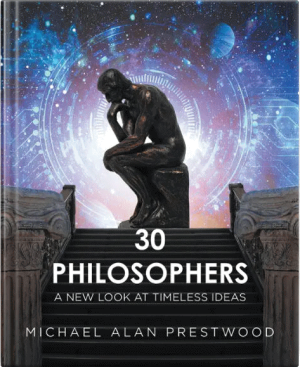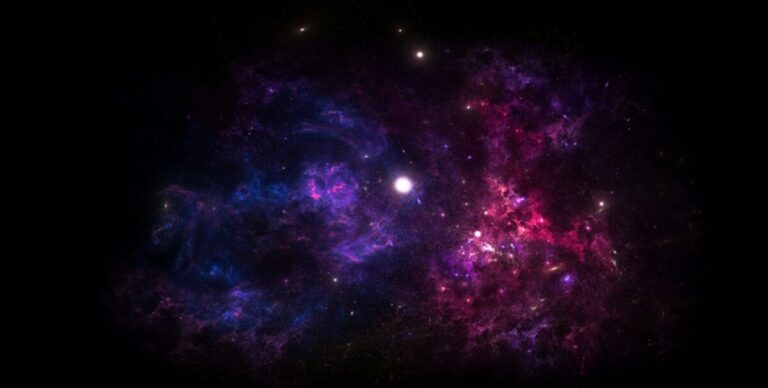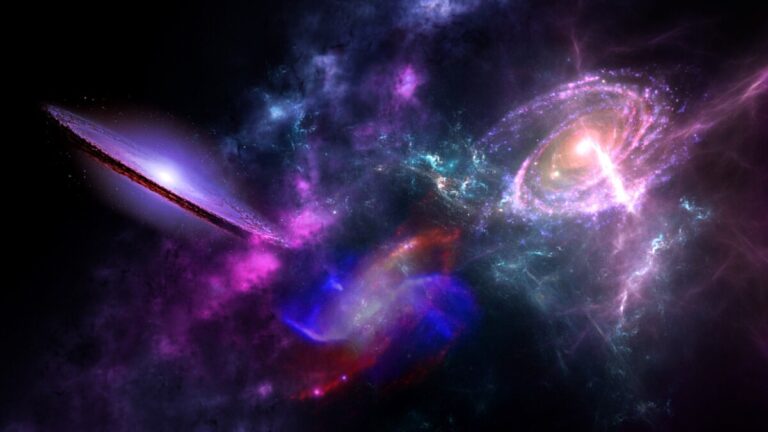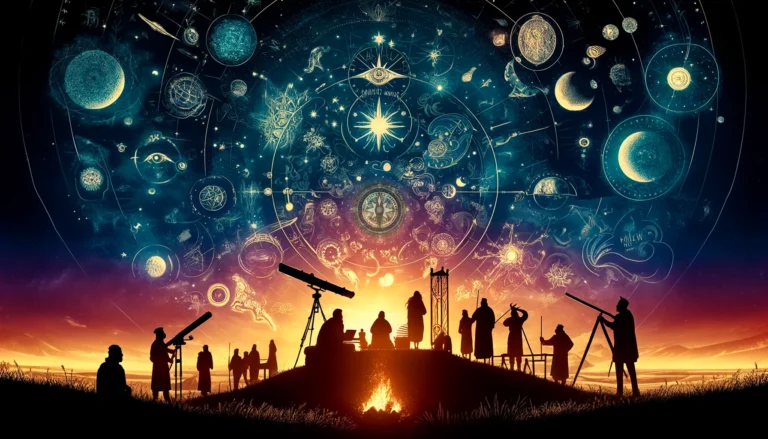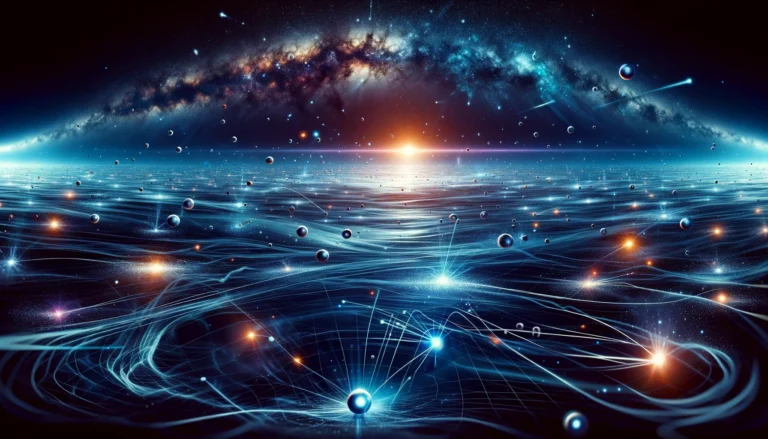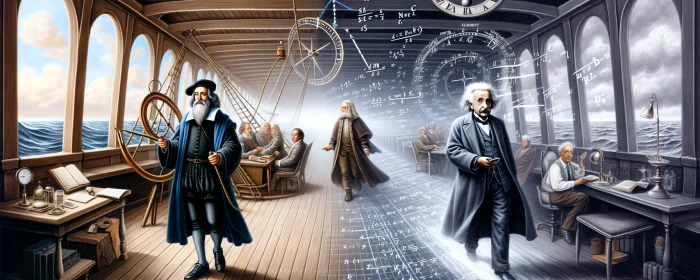In nature, waves interact with each other differently than solid objects do. Imagine throwing two rocks into a pond—the waves they create merge and influence each other in a smooth, interconnected way. Now picture two lines of billiard balls colliding. Instead of merging, they crash and scatter as individual objects. One behaves like a wave; the other like distinct particles.
In physics, the double-slit experiment reveals that tiny particles—like photons and even atoms—can behave as both waves and particles. That alone is fascinating and mysterious. But even stranger, when not observed, they behave like waves—interfering, overlapping, spreading out. The moment we observe them, they act like particles—taking just one path, one impact point, like tiny billiard balls.
This bizarre shift isn’t just about what we see—it’s about how we explain what we see. The observations are solid and repeatable. But the meaning behind them? That’s still unsettled, and the interpretations vary—from wavefunction collapse to parallel universes to something we haven’t discovered yet.
Personally, I like to frame the double-slit experiment as an ongoing debate about free will in physics. It is one of the key experiments that suggests the existence of true randomness in the universe. If true randomness exists, then free will may be real. If not, then we may only think we have free will—but don’t.
Let me explain. First, we’ll explore wave-particle duality in physics—then we’ll get philosophical.
The Experiment
In the modern double-slit experiment, physicists send single atoms toward a barrier with two narrow slits. But instead of behaving like a tiny bullet and hitting exactly where we aim, each atom follows a path that appears both random and predictable at the same time.
Think about what could happen to the atom:
-
It could pass through the first or second slit and land on a screen behind the barrier.
-
It could miss both slits entirely and bounce back.
-
It might clip the edge of a slit, altering its trajectory.
All of that makes perfect sense in a world where objects follow predictable paths.
But here’s where things get weird. Physicists observe what appears to be true randomness. The path of each individual atom is not certain. Over time, as more and more atoms are sent through the slits, their landing spots form a pattern—a pattern that looks just like a wave.
And this isn’t a fuzzy pattern. It’s an interference pattern—the kind you get when two waves collide and amplify or cancel each other out. The implication? It’s as if each atom is behaving like a wave, traveling through both slits at once and interfering with itself.
But when we try to observe which slit the atom actually passes through, the interference pattern disappears. The wave-like behavior vanishes, and the atom behaves like a classic particle again. The act of measurement changes the outcome.
Back in 1801, Thomas Young used this setup to prove light is a wave. The quantum twist only came much later when people ran the same experiment with electrons, atoms—even molecules. That’s when physicists realized: this isn’t just about light. This is something fundamental about how reality works.
Before the double-slit experiment, scientists believed that light, like sound, required a medium to travel through. We now know that’s not true—light doesn’t need a medium. Sound, on the other hand, cannot travel in a vacuum—a fact that ruins (or at least diminishes) most sci-fi movies for physicists.
Today, we use this experiment as a kind of flashlight into the unknown. It confirms that the behavior of the quantum world is different from the classical one. And yet, the deeper mystery remains: why does observation change the outcome? What counts as an “observer”? And what is actually happening when a particle goes from wave to particle?
This is where gravity enters the conversation. Unlike the other three fundamental forces—electromagnetism and the strong and weak nuclear forces—gravity refuses to fit into our quantum models. Some theorists are trying to force-fit it by imagining a gravity-carrying particle, the graviton, while others believe we may need an entirely new way of thinking.
The double-slit experiment, in this context, isn’t just strange. It may be a clue—one of the few experiments where the limits of quantum mechanics rub up against the limits of spacetime and gravity. In other words: we don’t just see something weird—we see the boundary of what we currently understand.

humanity’s 80 BEST IDEAS,
and the 30 GIANTS
behind them!
The epic story of how science, history, and philosophy shaped the modern mind.
Journey through 5,000 years of human thought, a fast-paced exploration of how ideas evolved, collided, and transformed the way we understand the world. Through the lives of 30 great thinkers and 80 pivotal ideas, discover how knowledge builds on itself and why critical thinking remains humanity’s greatest tool.
Go beyond snippets and surface-level takes. See how context reveals truth, and how understanding the past can sharpen the way you think today.
The Wave-Particle Duality
One of the strangest truths in physics is this: particles behave like waves. Not just light, but also electrons, atoms, and even molecules. In principle—yes—even you and me.
This phenomenon is called wave-particle duality, and it flips our intuition on its head. We used to think things were either particles or waves. But quantum experiments, especially the double-slit setup, show that the same object can behave as both—depending on how you interact with it.
It started with light. In the early 1800s, light was shown to behave like a wave. But by the early 1900s, scientists realized that light also came in discrete packets—photons—like particles. Then came the real twist: electrons, long assumed to be simple particles, also displayed wave-like behavior in experiments. Eventually, we saw the same thing with entire atoms and even complex molecules like buckyballs.
In everyday life, we instinctively understand the difference between waves and particles. Noise-canceling headphones work because sound is a wave—by generating an opposing wave, they cancel out unwanted noise. But if someone fires a machine gun at you, there’s no “anti-bullet wave” that can cancel out the incoming rounds. Yet in the quantum world, particles can interfere, even cancel each other out—strong evidence that they carry wave properties at tiny scales.
This wave nature also opens the door to other quantum oddities—superposition, where a system exists in multiple states at once, and entanglement, where two particles act as one even across great distances. These effects don’t make sense under classical physics, but they fall naturally out of wave-based math. It’s as if our universe is playing a deeper game, and the rules only show themselves when things get small enough.
That said, the wave-like behavior doesn’t scale well. In our universe, we can only observe this effect clearly for objects up to about 10,000 atoms in size. Beyond that, the wave properties become negligible. Still, the fact that everything has a wave nature—however faint at large scales—remains one of the most profound and unsettled truths in physics.
From Light to Particles
For centuries, scientists have explored the nature of waves and particles, beginning with light. We’ve long known that sound requires a medium to travel—air, water, or solid matter. Ancient thinkers like Aristotle speculated about this, and by 1801, Thomas Young’s double-slit experiment provided strong evidence that light, too, behaves like a wave—suggesting it might also need a medium to propagate.
At the time, scientists proposed a mysterious, invisible substance called “luminiferous ether” to explain how light could travel through empty space. This idea held sway until 1887, when the Michelson-Morley experiment showed that no such ether exists—space is, in effect, a vacuum.
That result changed everything. With no medium to wave through, light’s wave nature no longer made complete sense. In response, some physicists leaned toward a particle-based view of light.
Then, in 1905, Einstein’s work on the photoelectric effect settled the matter in a surprising way: light sometimes behaves like discrete particles—photons—especially when it interacts with matter. Light wasn’t a wave or a particle. It was somehow both.
By the 1920s, quantum mechanics expanded this idea, revealing that not just light, but also electrons, atoms, and even molecules can exhibit wave-like and particle-like behavior, depending on how they’re measured.
This duality was not just surprising—it was disturbing. It reshaped everything we thought we understood about light and matter. It forced physicists to rethink what we mean by a “thing.” Is an electron real before we measure it? Does observation create outcomes? Or reveal them?
This philosophical tension gave rise to multiple interpretations of quantum mechanics. Some, like the Copenhagen interpretation, suggest that observation collapses the wave of probabilities into a single outcome. Others, like the Many Worlds Interpretation, claim that all outcomes occur—but in separate, branching universes.
At its core, this strange history—from ether to photons—reminds us that every answer in science opens a deeper question. What we observe is clear. What it means? We’re still debating.
The Mystery Deepens
Since the early 20th century, experiments have confirmed that all quantum objects—photons, electrons, atoms, even large molecules—move and interact with the world as both waves and particles. This isn’t a one-off anomaly. It’s a consistent, repeatable truth of nature.
How to explain it? That’s where things splinter.
Some physicists interpret this as evidence of true randomness in the universe—that the future is not predetermined, and outcomes arise probabilistically. Others see it as a window into something bigger: a multiverse, where all possible paths exist simultaneously, and what seems random here is simply one branch of a broader, wave-like reality unfolding across many worlds.
But the real strangeness comes from how observation changes behavior.
In the double-slit experiment, if we simply watch where particles land, we get a wave-like interference pattern—as if each particle traveled through both slits and interfered with itself. But the moment we try to catch it in the act—to observe which slit it actually goes through—the wave pattern disappears. The particle “chooses” a path, and the interference vanishes.
It’s not just that we disrupt the system by measuring. It’s that the outcome depends on whether measurement happens at all. This is the heart of the observer problem: in the quantum world, how we choose to measure determines what reality appears to be.
And to this day, no one fully understands why.
Some theories attempt to explain this through wavefunction collapse—a sudden shift from possibility to reality. Others claim there is no collapse, only branching paths. Still others argue that consciousness, spacetime, or something even deeper must be involved.
What’s clear is this: the double-slit experiment is not just a physics demonstration. It’s a keyhole. And what we see through it is nothing less than the edge of our understanding.
Philosophical Viewpoint
Science focuses on observations and predictions—measuring what happens and forecasting what’s likely to happen next. Philosophy, on the other hand, steps back and asks: What does it all mean?
We know the universe is built from just 17 or 18 fundamental particles and governed by four fundamental forces. But what are these particles, really? Are they stable building blocks, flowing deterministically like a river? Or are they shifting probabilities—suggesting that choice, chance, and possibility are built into the structure of reality itself?
In a deterministic universe, every future state is simply the inevitable result of what came before. We are carried along by the tide, and what feels like decision-making is just the unfolding of prior conditions. In that world, free will is an illusion.
But quantum mechanics challenges this. Some experiments suggest the universe includes true randomness—events that are not determined by any prior cause, only by probabilities. If that’s the case, then maybe there’s room for independent action. Not chaos, but agency. Not a breakdown of order, but a deeper kind of freedom.
Even among physicists, the debate continues. Some believe randomness is real and fundamental. Others argue that what appears random is simply the result of hidden variables—things we don’t yet understand.
This tension ties directly to free will, consciousness, and our place in the cosmos. Are we surfing a sea of possibility, shaping our path through a probabilistic world? Or are we riding the current of a river that was always going to flow exactly this way?
The double-slit experiment doesn’t answer these questions—but it cracks the door open. It shows us that how we measure the world affects what we see. And that might be the first clue that how we live in the world matters too.
Does the Multiverse Solve the Mystery?
Some physicists interpret the randomness we observe—such as the unpredictable behavior of particles in quantum experiments—as evidence that free will exists within our single, observable universe. If outcomes truly aren’t determined in advance, then perhaps our choices aren’t either.
Others take a very different approach. They argue that what appears to be randomness is actually the result of a deeper order—one that spans a multiverse. Perhaps something we can think of as strings through other dimensions or as branching realities.
In this view, all possible outcomes of a quantum event actually occur, but in separate branches of reality. Every time a quantum event could go one of multiple ways, the universe splits—or branches—into versions where each possibility is realized. What looks like chance from within one branch is, from the multiverse perspective, just one path in a vast, structured landscape.
From the perspective of any one universe, the path of a single particle appears random. But step back—and you see that all outcomes form an interconnected, wave-like structure across many worlds. In this framework, randomness is an illusion. What we call “chance” is simply the thread we happen to follow in a tapestry of quantum possibilities.
Some theorists even connect this to quantum entanglement, where particles remain mysteriously linked across vast distances. Could this connection be the result of hidden dimensions? Or are entangled particles just part of the same system, still unified across separate branches?
These questions echo through some of the most famous words ever spoken about physics. Einstein famously called entanglement “spooky action at a distance,” and resisted the idea of fundamental randomness with his remark:
“God does not play dice with the universe.”
But despite all we’ve learned, the paradoxes remain. The multiverse may offer one way out of the mystery—but it opens up entirely new ones of its own.
The Deep Paradox of Reality
At its core, the double-slit experiment reveals a fundamental truth: nature plays by two sets of rules. The quantum world exhibits both deterministic, wave-like behavior and probabilistic, particle-like outcomes. This duality is the heart of quantum mechanics—and it deeply challenges our classical, Newtonian view of a fully predictable universe.
In Newton’s model, gravity is a force—objects pull on each other across space. But Einstein replaced that idea with something more elegant and strange: space and time are a fabric, and mass bends that fabric, creating what we experience as gravity. That shift—from force to geometry—was one of the greatest breakthroughs in science.
Yet even Einstein’s model doesn’t mesh with quantum theory. Gravity remains the one force we haven’t fully quantized. While electromagnetism and the nuclear forces work seamlessly in the quantum realm, gravity refuses to fit. Some physicists are searching for a hypothetical particle—the graviton—that might reconcile this. Others believe gravity could be emergent, not fundamental at all.
That’s why experiments like the double-slit matter so much. They don’t just challenge our understanding of particles or light—they hint that something deeper is going on, something that may connect quantum weirdness to the curvature of spacetime itself.
And woven through all of this is the question of free will. If quantum outcomes truly emerge from chance, not certainty, then perhaps so do our choices. But if the multiverse is real—and all possibilities play out somewhere—then our path is just one of many, and our sense of control may be more limited than we think.
The double-slit experiment doesn’t solve these mysteries. But it exposes them—with elegance, simplicity, and enduring power. It reminds us that even the smallest particles can lead us to the biggest questions.
— map / TST —
Get the full story…
Nothing beats the long-format of a book for clearly telling a grand story. For a deeper exploration of how science fits within the broader landscape of modern human thought, check out my new book, “30 Philosophers,” where I tell the story of the greatest ideas that have shaped humanity over the last 5,000 years.
30 Philosophers: A New Look at Timeless Ideas
humanity’s 80 BEST IDEAS,
and the 30 GIANTS
behind them!




